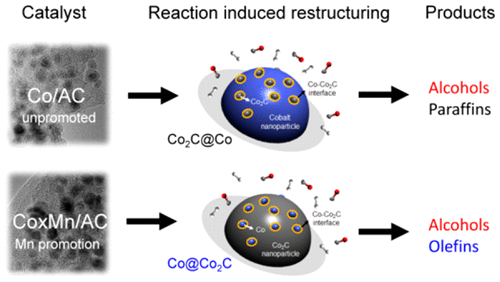当前位置:
X-MOL 学术
›
ACS Catal.
›
论文详情
Our official English website, www.x-mol.net, welcomes your feedback! (Note: you will need to create a separate account there.)
Insight into the Formation of [email protected]2C Catalysts for Direct Synthesis of Higher Alcohols and Olefins from Syngas
ACS Catalysis ( IF 11.3 ) Pub Date : 2017-12-05 00:00:00 , DOI: 10.1021/acscatal.7b02403 Ziang Zhao 1, 2 , Wei Lu 1 , Ruoou Yang 2, 3 , Hejun Zhu 1 , Wenda Dong 1 , Fanfei Sun 2, 3 , Zheng Jiang 3 , Yuan Lyu 1 , Tao Liu 1 , Hong Du 1 , Yunjie Ding 1, 4
ACS Catalysis ( IF 11.3 ) Pub Date : 2017-12-05 00:00:00 , DOI: 10.1021/acscatal.7b02403 Ziang Zhao 1, 2 , Wei Lu 1 , Ruoou Yang 2, 3 , Hejun Zhu 1 , Wenda Dong 1 , Fanfei Sun 2, 3 , Zheng Jiang 3 , Yuan Lyu 1 , Tao Liu 1 , Hong Du 1 , Yunjie Ding 1, 4
Affiliation

|
Cobalt carbide (Co2C) has recently been reported to be efficient for the conversion of syngas (CO+H2) to lower olefins (C2–C4) and higher alcohols (C2+ alcohols); however, its properties and formation conditions remain ambiguous. On the basis of our previous investigations concerning the formation of Co2C, the work herein was aimed at defining the mechanism by which the manganese promoter functions in the Co-based catalysts supported on activated carbon (CoxMn/AC). Experimental studies validated that Mn facilitates the dissociation and disproportionation of CO on the surface of catalyst and prohibits H2 adsorption to some extent, creating a relative C-rich and H-lean surface chemical environment. We advocate that the surface conditions result in the transformation from metallic Co to Co2C phase under realistic reaction conditions to form [email protected]2C nanoparticles, in which residual small Co0 ensembles (<6 nm) distribute on the surface of Co2C nanoparticles (∼20 nm). Compared with the Co/AC catalyst, where the active site is composed of Co2C phase on the surface of Co0 nanoparticles (Co2[email protected]), the Mn-promoted catalysts ([email protected]2C) displayed much higher olefin selectivity (10% versus 40%), while the selectivity to alcohols over the two catalysts are similar (∼20%). The rationale behind the strong structure–performance relationship is twofold. On the one hand, Co–Co2C interfaces exist universally in the catalysts, where synergistic effects between metallic Co and Co2C phase occur and are responsible for the formation of alcohols. On the other hand, the relative C-rich and H-lean surface chemical environment created by Mn on the [email protected]2C catalysts facilitates the formation of olefins.
中文翻译:

从合成气直接合成高级醇和烯烃的[受电子邮件保护的] 2 C催化剂形成的见解
最近有报道称,碳化钴(Co 2 C)可有效地将合成气(CO + H 2)转化为低级烯烃(C 2 -C 4)和高级醇(C 2+醇)。但是,其性质和形成条件仍然不明确。基于我们先前关于Co 2 C形成的研究,本文的工作旨在确定锰助催化剂在活性炭负载的Co基催化剂(CoxMn / AC)中所起作用的机理。实验研究证实,Mn促进了催化剂表面CO的解离和歧化,并阻止了H 2的生成。在一定程度上吸附,创造了一个相对富碳和贫氢的表面化学环境。我们主张表面条件导致在实际反应条件下从金属Co转变为Co 2 C相,形成[受电子邮件保护的] 2 C纳米颗粒,其中残留的小Co 0团簇(<6 nm)分布在Co的表面上2 C纳米粒子(〜20 nm)。与Co / AC催化剂(其中活性位点由Co 0纳米颗粒的表面上的Co 2 C相组成(Co 2 [受电子邮件保护])相比,Mn促进的催化剂([受电子邮件保护] 2C)显示出更高的烯烃选择性(10%对40%),而在两种催化剂上对醇的选择性相似(〜20%)。强大的结构与绩效关系背后的理由是双重的。一方面,Co-Co 2 C界面普遍存在于催化剂中,其中金属Co和Co 2 C相之间会发生协同作用,并负责形成醇。另一方面,由Mn在[受电子邮件保护的] 2 C催化剂上产生的相对富C和贫H的表面化学环境促进了烯烃的形成。
更新日期:2017-12-05
中文翻译:

从合成气直接合成高级醇和烯烃的[受电子邮件保护的] 2 C催化剂形成的见解
最近有报道称,碳化钴(Co 2 C)可有效地将合成气(CO + H 2)转化为低级烯烃(C 2 -C 4)和高级醇(C 2+醇)。但是,其性质和形成条件仍然不明确。基于我们先前关于Co 2 C形成的研究,本文的工作旨在确定锰助催化剂在活性炭负载的Co基催化剂(CoxMn / AC)中所起作用的机理。实验研究证实,Mn促进了催化剂表面CO的解离和歧化,并阻止了H 2的生成。在一定程度上吸附,创造了一个相对富碳和贫氢的表面化学环境。我们主张表面条件导致在实际反应条件下从金属Co转变为Co 2 C相,形成[受电子邮件保护的] 2 C纳米颗粒,其中残留的小Co 0团簇(<6 nm)分布在Co的表面上2 C纳米粒子(〜20 nm)。与Co / AC催化剂(其中活性位点由Co 0纳米颗粒的表面上的Co 2 C相组成(Co 2 [受电子邮件保护])相比,Mn促进的催化剂([受电子邮件保护] 2C)显示出更高的烯烃选择性(10%对40%),而在两种催化剂上对醇的选择性相似(〜20%)。强大的结构与绩效关系背后的理由是双重的。一方面,Co-Co 2 C界面普遍存在于催化剂中,其中金属Co和Co 2 C相之间会发生协同作用,并负责形成醇。另一方面,由Mn在[受电子邮件保护的] 2 C催化剂上产生的相对富C和贫H的表面化学环境促进了烯烃的形成。















































 京公网安备 11010802027423号
京公网安备 11010802027423号